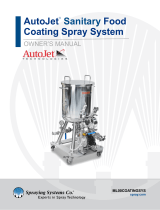14
5.5 PROGRAMMING THE LEVEL SENSOR
The tank level sensor comes pre-programmed. However, the setpoints can be adjusted to congure the system
specically for the applicaon.
The level sensor displays the tank level as a percent (%) full. However, all parameters are measured in millimeters
(mm) from the boom of the probe. The usable range of the level sensor is between 10 mm and 410 mm from the
boom of the probe, a 400 mm range.
There are two switching outputs that can be adjusted: Q1 and Q2. Output Q1 is used for the Auto-Rell feature and
output Q2 is used for the Low Tank Level indicator.
*Italicized parameters are preset and should only be changed in the event of a factory reset.
To access the above parameters from the main display (% full), press and hold the “Set” buon. Use the up and down
arrows to navigate to “Q1MENU” or “Q2MENU” and press the “Set” buon. Use the up and down arrows to navigate
to “SP1” or “RP1” (or “SP2” and “RP2”) and press the “Set” buon. Use the up and down arrows and the “Set” buon
to change the numeric values assigned to the given parameter. Instrucons for seng other parameters can be found
on pages 32-35 of the provided component manual (LS00FP1000G1NMB).
Assuming the tank has been inially lled and given the values in the above table, as the system is being used the level
in the tank will decrease. Once the uid reaches 250 mm from the boom of the probe, 63% full (100% * (250-
10)/380=63%), Auto-Rell will turn on. As the uid level rises and reaches 390 mm from the boom of the probe,
100% full, Auto-Rell will be turned o.
If Auto-Rell is switched o or the supply is interrupted, and the uid level reaches 10 mm from the boom of the
probe, 0% full, the Low Tank Level indicator will turn on. This is intended as a warning that the system is not
automacally relling. The Low Tank Level indicator will turn o once the uid level rises above 50 mm from the
boom of the probe, 10% full.
Operang within a small range with the tank mostly full, like in the above example, is ideal for maintaining the
temperature of the system while using Auto-Rell. When using Auto-Rell and the supply uid is within 15°F of the
nal temperature, it is not necessary to use a short-range ll cycle.
HEATING THE SYSTEM
Set temperature on the heater via the heat controller screen on the front panel. Once the system is lled and the
heang uid is circulang properly, turn on the heater. Wait unl the system reaches the desired setpoint. At this
point the uid has expanded to its full capacity, and any excess will escape the relief port on the return reservoir.
-For spray control operaon please reference the provided 1750+/2150+ Spray Control Panel Owner’s Manual.
Output Parameter Name Descripon Preset
Q1
SP1 Switching Point 1 High Level – Auto-Rell stops lling 390 mm
RP1 Reset Point 1 Low Level – Auto-Rell begins lling 250 mm
OU1 Switching Funcon Output type – (Normally Open/Closed) Qx-Hnc
Q2
SP2 Switching Point 2 Not Low Level – Indicator will turn o at or
above this value (SP2=RP1 + 10) 50 mm
RP2 Reset Point 2 Low Level – Indicator will turn on at or below
this value (RP2=RP1) 10 mm
OU2 Switching Funcon Output type – (Normally Open/Closed) Qx-Hno
NA QAHIGH High Range Limit Maximum tank level (QAHIGH>QALOW) 390 mm
NA QALOW Low Range Limit Minimum tank level 10 mm
NA Length Probe Length Length of probe for this applicaon 558 mm
NA DspVal Display Value Sets display value to % of usable range Percen
























